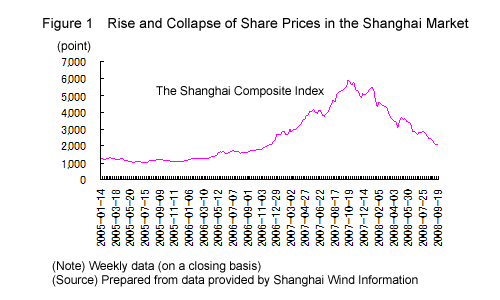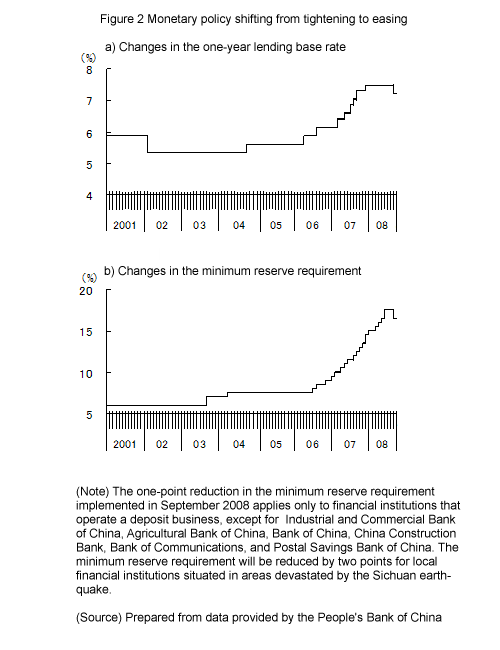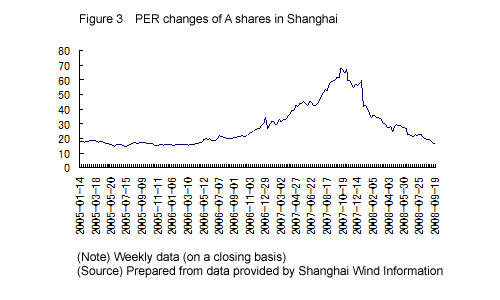Just like in other major markets, stock prices in China plummeted with the mid-September bankruptcy of Lehman Brothers, a leading American securities firm, and the deepening of the financial crisis that had begun in the United States. To stabilize the financial market, the Chinese authorities immediately took action to shore up share prices, such as easing monetary policy by combining a rate cut with a reduction in the minimum reserve requirement, as well as a reduction of and partial exemption from stamp duty. Thanks also to the Sept. 20 U.S. government announcement of comprehensive financial stability measures centered on the disposal of bad debts through the introduction of public funds, stock prices in China rebounded sharply.
Stock bubble bursts
Beginning with the subprime mortgage crisis in the U.S. last summer, share prices have been collapsing on a global scale ever since. Initially, the correction of share prices in China remained small, and the so-called decoupling phenomenon, whereby the Chinese economy would not be as significantly affected by overseas economies because of its high growth rate, attracted attention. However, with the impact of the subprime crisis spreading from international financial markets to real economic activity worldwide, the fallout from the spontaneous decline in overseas stock prices finally reached the Chinese market. Particularly since mid-January 2008, the decline in the Shanghai Composite Index has been the largest among the major markets.
The Shanghai Composite Index dropped sharply by approximately 10% during the Beijing Olympic Games, and it headed further downward in September, triggered by the Lehman Brothers bankruptcy. The Index fell below 1900 points on Sept. 18, which was about 70% below the 6092 points recorded on Oct. 16, 2007 (figure 1).

However, foreign currency assets make up only a very small portion of the total assets of Chinese financial institutions as China has maintained relatively strict capital controls. According to announcements made by leading Chinese financial institutions, their exposure to subprime loans and direct losses incurred as a result of the Lehman Brothers bankruptcy are limited. Nevertheless, funds throughout the world have been flowing out of the stock market and into “safe assets” such as government bonds and gold, reflecting rising financial instability, and the flight away from shares has also accelerated in China.
Monetary policy shifting from tightening to easing
The Chinese authorities have changed their monetary policy stance from tightening to easing in order to restrict the impact of the international financial market turmoil on the domestic economy (figure 2).

The People's Bank of China announced a rate cut on Sept. 15, to be implemented on the following day. As a result, the one-year lending base rate was reduced by 27 basis points from 7.47% to 7.20%. The base rates for other terms were also cut according to the principle of the shorter the lending term, the larger the reduction and vice versa. However, deposit base rates have remained unchanged.
This was the first time that interest rates had been cut since February 2002, meaning that the rate-hike cycle that began in October 2004 has ended. During that time, interest rates were increased nine times to cool the overheated economy and contain inflation, and the one-year lending base rate was raised by a total of 2.16%. However, with the deceleration of the economy becoming evident at the time of a meeting of the Political Bureau of the Central Committee of the Communist Party of China on July 25, the Chinese government changed its macroeconomic policy from one of preventing economic overheating and inflation with a strong tightening policy to one of placing top priority on maintaining stable and fairly rapid economic development while controlling an excessively rapid rise in prices. The authorities embarked on the rate cut in an environment in which fear of inflation was receding, as observed by the inflation rate in terms of the CPI falling from a peak of 8.7% year-on-year in February 2008, to 4.9% in August.
In addition to the rate cut, the People's Bank of China also announced a reduction from 17.5% to 16.5% in the minimum reserve requirement for small- and medium-sized financial institutions, to be implemented on Sept. 25. The minimum reserve requirement was raised 19 times from April 2004 to June 2008 by a total of 11.5%, and the adjustment made this time was the first cut since November 1999.
Measures to shore up share prices are put in place
To stabilize the financial market, the authorities not only eased monetary policy, but also launched a series of measures to shore up share prices (“price keeping operations”).
On Sept. 18, the Ministry of Finance and the State Taxation Administration announced that the requirement for both parties to pay stamp duty on stock transactions would be changed to the transferor alone, with the revision implemented the following day. This followed a cut of the stamp duty rate from 0.3% to 0.1% on April 24. The purpose of these moves was to bolster the lackluster stock market by reducing stock trading costs.
On the same day, the State-owned Assets Supervision and Administration Commission (SASAC) of the State Council announced that it would support state-owned companies under its direct control to repurchase shares of their listed companies. Central Huijin Investment Company Limited (CHICL), a state-owned investment company, also said that it would increase its purchase of shares in the Industrial and Commercial Bank of China, China Construction Bank, and Bank of China, which CHICL already owned. The reform of non-tradable shares that was introduced in 2005, whereby non-tradable shares (state- and corporation-owned stocks) that accounted for two-thirds of market capitalization would become tradable after a certain lock-up period (maximum three years), led to fear of a worsening demand-supply balance and had been pushing share prices down. In contrast, the further purchase of shares by state-owned companies and investment firms is expected to improve the demand-supply balance and, in turn, lead to a rise in share prices.
As a result of the positive response to such measures, in addition to higher share prices on the New York Stock Exchange the preceding day, the Shanghai Composite Index climbed 7.8% on Sept. 22, following a sharp rebound of 9.5% on Sept. 19.
Prospects for the future
The average price-earnings ratio (PER) of the Shanghai market was 70 last October when share prices were at their peak, reaching nearly the same level as that of the Tokyo market during its bubble in the 1980s. However, the average PER in the Shanghai market has now fallen to around 15, the same as that of the current sluggish Tokyo market, reflecting a collapse in share prices since the peak (figure 3). Given that China is an "emerging economy" with high growth potential, the appropriate PER level is considered to be around 30. Taking this as a benchmark, both the PER of 70 at the peak and the current PER of 15 are extreme.

Triggered by the Sept. 20 U.S. government announcement of comprehensive financial stability measures centered on the disposal of bad debts through the introduction of public funds, expectations are rising that global financial insecurity will wind down. Following this announcement, the Shanghai market rebounded sharply, as did other major markets. Although the Chinese economy is likely continue to decelerate for some time to come, the expected fall in inflation will provide further room for monetary easing. Thanks also to “price keeping operations” by the authorities, share prices that have been falling for the past year are about to finally reach a turning point.


